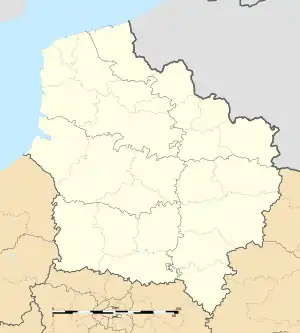Gommecourt, Pas-de-Calais
Gommecourt (French pronunciation: [ɡɔmkuʁ]) is a commune in the Pas-de-Calais department in the Hauts-de-France region of France.[3]
Gommecourt | |
|---|---|
_-_Rue_principale.JPG.webp) The main road of Gommecourt | |
 Coat of arms | |
Location of Gommecourt | |
 Gommecourt  Gommecourt | |
| Coordinates: 50°08′27″N 2°38′46″E | |
| Country | France |
| Region | Hauts-de-France |
| Department | Pas-de-Calais |
| Arrondissement | Arras |
| Canton | Avesnes-le-Comte |
| Intercommunality | CC Sud-Artois |
| Government | |
| • Mayor (2020–2026) | Daniel Ledru[1] |
| Area 1 | 3.35 km2 (1.29 sq mi) |
| Population | 89 |
| • Density | 27/km2 (69/sq mi) |
| Time zone | UTC+01:00 (CET) |
| • Summer (DST) | UTC+02:00 (CEST) |
| INSEE/Postal code | 62375 /62111 |
| Elevation | 124–155 m (407–509 ft) (avg. 148 m or 486 ft) |
| 1 French Land Register data, which excludes lakes, ponds, glaciers > 1 km2 (0.386 sq mi or 247 acres) and river estuaries. | |
Geography
A small farming village situated 14 miles (23 km) south of Arras, on the D6 road.
History
Formerly within the ancient County of Artois, the village was redesignated within the new Department of the Pas de Calais after the French Revolution.
World War I
During most of the period of hostilities between 1914 and 1918 (World War I) Gommecourt was in the front line of the Western Front, occupied by the Imperial German Army, and was virtually destroyed as a result of the violence to which it was exposed.
The neighbouring villages of Hebuterne and Foncquevillers 800 yards or so to the west, being conversely in Allied forces occupation, were used as bases for an unsuccessful assault on Gommecourt carried out by the British Army on 1 July 1916, as a part of the Battle of the Somme offensive.
The German troops who defended the village during the battle were the 52nd Infantry Division from Baden together with 2nd Guards Reserve Division from Westphalia; the British troops taking part in the attack comprised the 56th (1/1st London) and the 46th (North Midland) Divisions.
The graves of the British casualties are located in a number of local war cemeteries around the site, the graves of German casualties having been relocated further North after the war to the Neuville-St Vaast German war cemetery.
Population
| Year | Pop. | ±% p.a. |
|---|---|---|
| 1968 | 169 | — |
| 1975 | 132 | −3.47% |
| 1982 | 132 | +0.00% |
| 1990 | 116 | −1.60% |
| 1999 | 126 | +0.92% |
| 2007 | 111 | −1.57% |
| 2012 | 109 | −0.36% |
| 2017 | 96 | −2.51% |
| Source: INSEE[4] | ||
Places of interest
- The church of St Martin, rebuilt, as was most of the village, after World War I.
- The Commonwealth War Graves Commission cemetery.
References
- "Répertoire national des élus: les maires". data.gouv.fr, Plateforme ouverte des données publiques françaises (in French). 9 August 2021.
- "Populations légales 2020". The National Institute of Statistics and Economic Studies. 29 December 2022.
- INSEE commune file
- Population en historique depuis 1968, INSEE